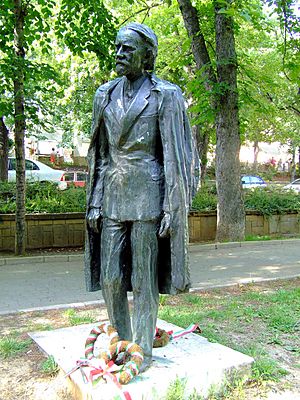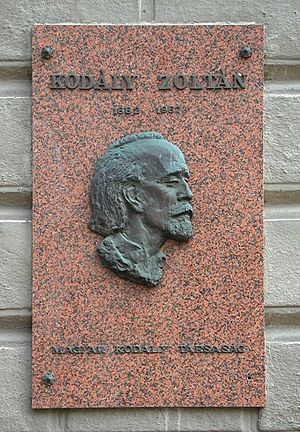Zoltán Kodály facts for kids
Zoltán Kodály (born December 16, 1882 – died March 6, 1967) was a famous Hungarian composer. He also studied folk music (an ethnomusicologist) and taught music (a music pedagogue). He is best known around the world for creating the Kodály method of music education.
Contents
Life of Zoltán Kodály
Zoltán Kodály was born in Kecskemét, which was part of the Kingdom of Hungary at the time. He started playing the violin when he was a child. In 1900, he began studying languages at the University of Budapest. At the same time, he took composition classes at the Royal Hungarian Academy of Music. After finishing his studies, he spent a year studying music in Paris.
Collecting Folk Songs
In 1905, Kodály traveled to small villages to collect traditional folk songs. He used special machines called phonograph cylinders to record them. In 1906, he wrote a paper about Hungarian folk songs. Around this time, Kodály met another Hungarian composer named Béla Bartók. Kodály taught Bartók how to collect folk songs. They became close friends and supported each other's music throughout their lives.

Kodály's music was very original. It mixed the complex style of Western European music with a deep love for Hungarian folk music. This included folk music from areas that are now part of Slovakia and Romania. Kodály did not become widely famous until 1923. This was when one of his most famous pieces, Psalmus Hungaricus, was performed for the first time. This concert celebrated the 50th anniversary of the cities of Buda and Pest joining together.
Kodály was married to Emma Gruber for 48 years. After she passed away in 1958, he married Sarolta Péczely in 1959. She was one of his students at the Franz Liszt Academy of Music. They were happily married until his death in 1967 in Budapest. He was 84 years old.
In 1966, Kodály visited the United States. He gave a special talk at Stanford University, where some of his music was played for him.
Kodály Method of Music Education
Throughout his life, Kodály was very interested in how music was taught. He wrote many materials about teaching methods. He also composed a lot of music specifically for children to use. Starting in 1935, he worked with his friend Jenő Ádám to improve music teaching in Hungarian schools. Their work led to several important books being published.
Goals of the Kodály Method
The main goals of the Kodály method can be summed up like this:
- Music is for everyone, not just a few people.
- Learning music should happen step-by-step, starting with what a child can understand.
- Children should begin learning music when they are very young.
- The way music is taught should be logical, similar to how children learn their first language.
- Music classes should be fun and keep students interested.
- Singing is the best and most important way to learn music ideas.
- Teachers should use good quality folk songs from the students' own language.
The music education program that grew in Hungary in the 1940s became the basis for the Kodály Method. Kodály himself did not write one big book called "The Kodály Method." Instead, he set out a group of ideas for music education. These ideas were used by many teachers, especially in Hungary and other countries, after World War II. His ideas also led to the creation of Kodály hand signs, which help students learn musical notes.
In the movie Close Encounters of the Third Kind, a way of learning using hand signals for musical notes was called the Kodály Method.
Legacy and Memorials
The city of Pécs built a bronze statue of Kodály in 1976. It is located in Szent István square. The sculptor wanted the statue to face a former playground. This way, it would be looking towards children, whose music education was very important to Kodály. The statue shows him as an older man, walking quietly among the trees.
During the Hungarian Revolution of 1956, some groups suggested that Kodály should become the president of the government. They wanted him because he was so well-respected in Hungary and around the world.
Selected Musical Works
- Stage Works
- Háry János, Op. 15 (1926) – An opera about a Hungarian folk hero.
- Székelyfonó (The Spinning Room) (1924–1932) – Another opera.
- Orchestral Works
- Idyll Summer Evening (1906, revised 1929)
- Háry János Suite (1926) – Music from the opera, played by an orchestra.
- Dances of Marosszék (1929) – Folk dances arranged for orchestra.
- Dances of Galánta (1933) – Another set of folk dances for orchestra.
- Variations on a Hungarian folk song (Fölszállott a páva, or The Peacock Roared, 1939)
- Symphony in memory of Toscanini (1961)
- Chamber or Instrumental Music
- Adagio for Violin (or Viola or Cello) and Piano (1905)
- Duo for Violin and Cello, Op. 7 (1914)
- Sonata for Solo Cello, Op. 8 (1915)
- Marosszéki táncok (Dances of Marosszék, for piano, 1927)
- Choral Music
- Este (Evening) (1904)
- Psalmus Hungaricus, Op. 13 (1923) – A large work for choir and orchestra.
- Mátrai képek (Mátra Pictures) for choir without instruments (1931)
- Jézus és a kufárok (Jesus and the Traders) for choir without instruments (1934)
- Te Deum for Buda Castle (1936) – A religious song for choir.
- Missa brevis for choir and Organ (1942)
Images for kids
See also
 In Spanish: Zoltán Kodály para niños
In Spanish: Zoltán Kodály para niños
- Solfège, a music education method used to teach pitch and sight singing





